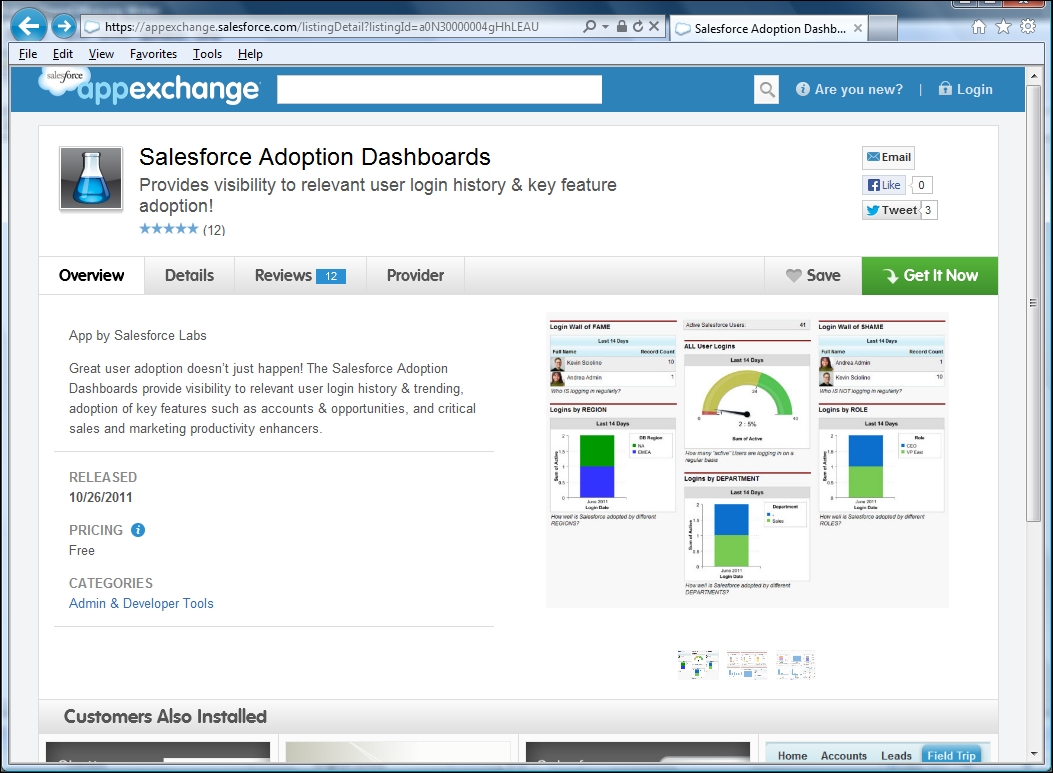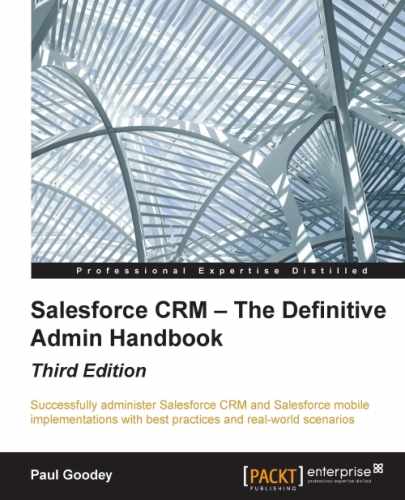In Chapter 7, Salesforce CRM Functions, we looked at the core functionality that Salesforce CRM provides and also at how the complete sales process, from campaign and lead capture right through to customer service and support, can be captured.
There, we looked in detail at how Salesforce provides the facilities to obtain a full 360-degree view of the customer's past, present, and future relationships within our organization.
We looked at how this information enables marketing to measure the return on investment for marketing campaigns, sales to optimize the sales pipeline and sell more to each customer, support to track customer support incidents, and requests to ensure that each one is resolved appropriately and in a timely fashion.
Having this process in place is one thing, but to ensure that the information is captured to support the process is another issue altogether. After all, processes and technologies are only as good as the people who use them so it is vital that users regularly log in, create, and update information into Salesforce CRM.
CRM technology, therefore, must be easy to use, accessible, and scalable to ensure that the efforts of using the system provide significant enhancements in productivity, efficiency, and information accessibility. Once the business goals have been established and can be measured, organizations generally need to address methods to ensure or increase user adoption. Here, you can cultivate active product advocates or evangelists from within your business to support certain initiatives for any relevant areas of the business.
A significant factor for successful adoption is to give users incentives to use the system by providing them with functionality that improves the way they work and offers valuable information and tools that are not available elsewhere within the organization.
Another important consideration is to encourage feedback from the user community. By encouraging feedback and instilling a sense of collaboration, a collective ownership for Salesforce CRM can be obtained, which will instill trust. Responding to good suggestions, customizing, and communicating enhancements to the application can lead to better acceptance of changes and makes people more likely to want to spend their time working with the application.
In spite of the positives mentioned, user adoption cannot be assumed or taken for granted, and your company might need to consider reinforcing adoption with rules as well as rewards.
User adoption seeks to ensure that the business communities, as described previously, are effectively using Salesforce CRM and that the features that have been implemented are being properly utilized and continue to successfully address the business challenges.
To enable the monitoring of user adoption, there need to be effective reports and dashboards to capture adoption metrics where the following areas can be considered when building user adoption metrics:
- Usage
- Data quality
- Business performance
The first key requirement to ensure that Salesforce CRM is being appropriately used is by measuring the number and frequency of users logging in to the system. You also need to ensure that users are actively and consistently updating data and creating new Leads, Contacts, Opportunities, Cases depending on their roles in the organization.
Having a well-implemented business application should help make the business processes simple and hide complexity; this all helps increase user adoption. However, making a computer application appear simple often requires a considered approach and sometimes, takes far more effort than leaving it in its natural complex state. Removing obstacles and unnecessary features takes time and effort, but it is time and effort well spent, and will hopefully result in higher adoption rates.
As a platform, Salesforce CRM has proven to be highly successful since its conception a decade ago, and the number of organizations and subscriptions to the service grows year on year. Much of this success can be attributed to the simplicity, ease of use, and focus on user productivity that the platform affords.
While you might feel justified in introducing new mandatory fields and enforcing data capture requirements in the application, this can sometimes make the system less user friendly. Sometimes, applications that offer the simplest solution for a given problem are more likely to be rewarded with acceptance and adoption by your Salesforce community.
Enabling users to connect information from other tools, such as Microsoft Outlook, and fully integrating Salesforce CRM with other such business systems provides a mechanism to access all the information users need.
In the past, mobile devices that were capable of accessing software applications were very expensive. Often, these devices were regarded as a nice to have accessory by management and were seen as a company perk by field teams. Today, mobile devices are far more prevalent within the business environment, and organizations are increasingly realizing the benefits of using mobile phones and devices to access business applications.
Salesforce.com provides several mobile apps and solutions to keep your users connected and productive when using their mobile devices. These solutions are covered in detail in the next chapter, which is Chapter 10, Mobile Administration.
Users are far more likely to adopt Salesforce CRM when they know that their peers and colleagues are achieving results from its use. By communicating both the business and personal results—for example, an increase in company sales and the resulting sales commissions paid to the sales team—you can encourage others to adopt the system.
Data quality is a valuable metric to measure adoption. Although, it is advisable not to overcomplicate the entering of information with needless validation, it is important that any critical fields be complete.
When certain fields are consistently filled out, user acceptance will increase, as it provides good data integrity and reliability, which translates into higher user confidence and higher adoption.
Usage should also reflect business performance and compliance metrics that are used to ensure that users are not just using the application, but are using it in a way that enhances business effectiveness. Here, metrics that will uncover patterns and trends that track performance levels can be built, and can then identify areas that need improvement.
This has been a quick overview of areas that can be used to generate metrics that you can track, and there is an enormous quantity of metrics that can be generated.
There is a balance, however, in getting accurate views without overcomplicating and spawning too many metrics. Here, it is often best to create the minimum number of metrics that can adequately capture and track the success of the business performance objectives.
Certain performance indicators can be established to identify business sales revenues, which are listed as follows:
- Compare the current fiscal year with the last year's sales by month, say, to measure cyclical variances.
- Compare sales from existing customers against new customers to measure which type of customer revenue is coming in, and enhance CRM activities accordingly.
- Compare won and lost sales ratios to measure the effectiveness of deal closure, see why deals are being lost, and learn from the reasons.
- Measure the sales pipeline by sales stage to identify where new opportunities are appearing.
- Measure key opportunities in the sales pipeline to identify the current key opportunities and ensure they get the right attention.
- Measure closed sales actuals against quota. Here, you can introduce a closed sales leader board to identify who your top deal-closers are. This can sometimes be seen as a way to shame bad performers, but sales management can use this information positively to get the top performers to share knowledge and best practices to help the organization.
For marketing specific metrics, the following examples can be performed:
There are many dashboards that you can install from AppExchange that give metrics for how Salesforce is being used. The following is called Salesforce Adoption Dashboards, which is an example from Force.com Labs:

Note
The Salesforce Adoption Dashboards app from Labs is available from the AppExchange Marketplace directly through the following URL:
http://appexchange.salesforce.com/listingDetail?listingId=a0N30000004gHhLEAU
